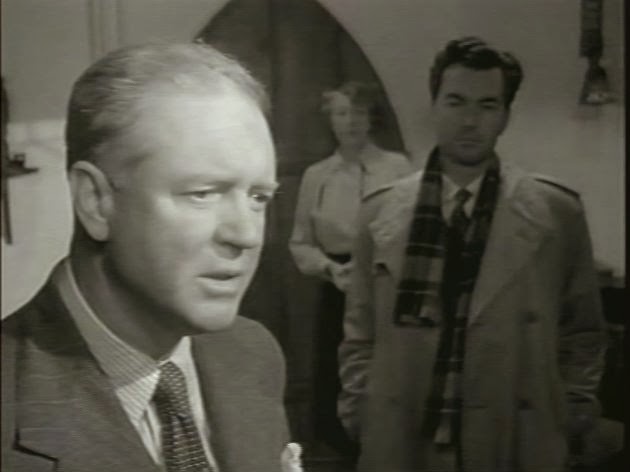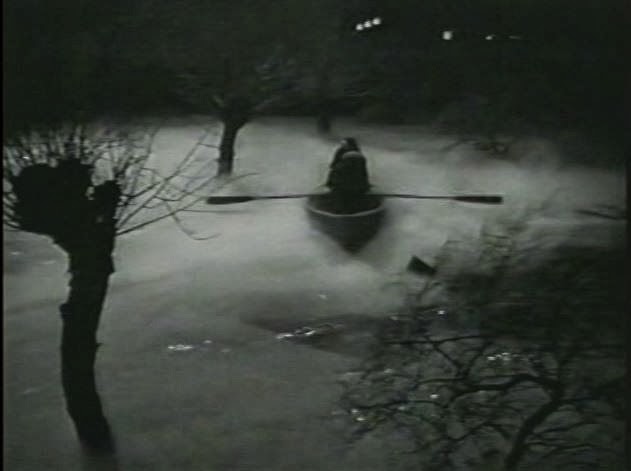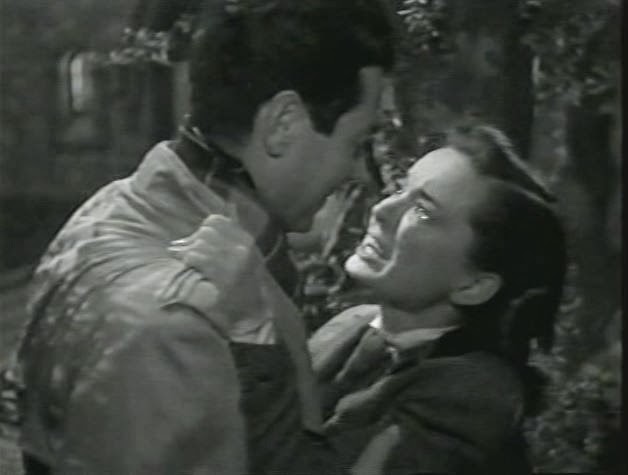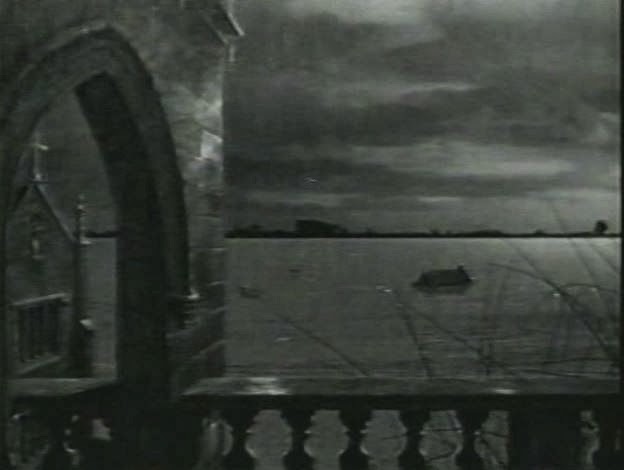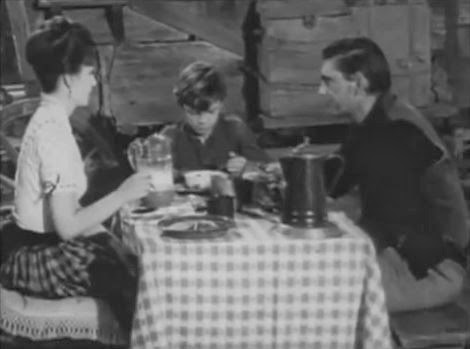Thunder on the Hill (1951) is a great stew of dark-and-stormy-night whodunit, character actor fest, and higher questions on what is faith and what is only fanatic assumption. Some of these aspects, not entirely married in the stew, fall to the bottom of the pot, neglected, and some rise again and again to the surface with a little stirring.
Connie Gilchrist is the cook in this film whose constant guardianship over soups and stews makes one inevitably hungry for some, and is responsible for the above gastronomic paragraph.
The movie stars Claudette Colbert as a nun with tragedy in her past and a troubled drive for excellence that creates conflict with those around her.
Ann Blyth is a convicted murderess on her way to the gallows, when she and practically the whole county of this rain-sodden chunk of England is forced to take refuge at the hilltop convent and hospital.
The movie was still tentatively titled Bonaventure, after the stage play by Charlotte Hastings from which the story is taken (Miss Colbert’s character name is Sr. Mary Bonaventure)—when a reporter allowed to observe a scene being filmed commented on Ann Blyth’s encounter with an on-camera breakfast.
“Spread before her is a dish of bacon and eggs, two slices of toast and a cup of tea. As the camera rolls, Ann methodically consumes her last meal.
‘Very good,’ says Director Douglas Sirk, ‘The action of the extras in the background wasn’t all it could be, though. I think we had better do it again.’
The prop man brings another helping of food from his portable steam table, and the scene is filmed again. This time, something goes wrong with the sound—and again Sirk calls for another take.
As the shot is finally completed to everyone’s satisfaction, Ann slumps back in her chair and pushes away the third empty dish of bacon and eggs.
‘Now I know what they mean when they say, ‘the condemned man ate a hearty breakfast,’ she gasped.”
Unfortunately, Ann’s Herculean task of eating three helpings of bacon, eggs and toast was for naught. The scene apparently ended up on the cutting room floor; you won’t see it in the movie.It was filmed early in the year 1951 (the article was published in February), and by December of that year, columnist Louella Parsons noted, “Ann Blyth, bright-eyed and happy, told me that 1951 had been the most exciting year of her entire life.”
It was certainly a busy one. Five of her films, the most in one year, were released in 1951, including I’ll Never Forget You (discussed here, and we’ll talk about it some more later on in the series), The Golden Horde, The Great Caruso, and Katie Did It(which I’m having a terrible time finding). They represent a variety of roles and genres, and this was perhaps the greatest satisfaction for her.
There were also several more radio performances, including two scenes from this movie played out on the Lux Radio Theater by Ann and Claudette Colbert. The episode covers eight films premiering in 1951. Listen here at the Internet Archive website and scroll down to “Movietime USA”. Their scene starts at 7:54 and afterwards is followed by a brief interview.
Ann Blyth was twenty-two years old when Thunder on the Hill was filmed, her name along with Miss Colbert’s above the title. Her stature in Hollywood had been cemented at this young age by her talent and popularity, but top movies would prove to be a challenge to get as the changing film industry, and changing society, advanced further into the 1950s.
Claudette Colbert, a major star for a couple decades, was a great example of both career excellence and longevity, but time and diminishing opportunities in a coming era when her "type" of the elegant and sassy woman was replaced by a new wave of younger gamines and sexpots. Ann Blyth’s film career, despite her being much younger, would end before the decade was over for some of the same reasons. They both represented an era of actresses who radiated class, intelligence, and dignity, but in the years would not find much of a place on film.
Author Lawrence T. Quirk in Claudette Colbert, An Illustrated Biography, notes, “Ann Blyth recalled her work with Colbert as a delightful experience, mentioning that unlike other great stars she had appeared with…Colbert was a relaxed, down-to-earth, infinitely secure person, disciplined about the projection of her talent, gracious to all those about her.”Gladys Cooper, who plays the Mother Superior in the film, he quoted, “Claudette is a professional, and even when the material is thin and rather pedestrian, as I thought that film unfortunately tended to be, she gives it her best efforts.”
That the plot of Thunder on the Hill seemed a “pedestrian” and standard English murder mystery, with all the suspects gathered in one place at the climax, is the most common observation on this film. While that may be intended as a complaint, I don’t see the plot, simply because it is standard, is a downfall. There are only so many stories out there, and none of them are new.
I would suggest that more could have been done to season the stew simply by paying more attention to ingredients that were on hand: including the superstitious and judgmental townsfolk who are uncomfortable with having a murderer take refuge with them from the storm—versus the images of clemency, salvation and redemption present in the Catholic icons of the convent and hospital. I was quite surprised to read director Douglas Sirk, who specialized in glossy melodramas, dismiss the idea that the film should contain any reference to religion. In an interview with author Jon Halliday in Sirk on Sirk, Mr. Sirk comments:
“I wanted this picture to have nothing to do with religion. For me, there is one interesting theme in it: this girl (Ann Blyth) being taken to the gallows, the storm, the delay, and so on. This should have been the only thing the picture was about. There was no story in the Claudette Colbert part. But for various reasons, including the fact that the producer blew most of the budget building that fantastic convent in Hollywood, when we could have gone on location somewhere, they kept pushing it towards religion the whole time.”
I think Mr. Sirk was missing the elephant in the room this time around. The villagers are escaping a devastating flood and flee to the highest ground near them, on which sits a convent and hospital run by nuns. They’re not going to the McDonald’s on the hill; they’re going to the convent on the hill. Just the image of being on higher ground sets a symbolic tone to a brooding story about being right and being wrong, being guilty and being innocent, always with the image of a young woman, guilty or not, about to hopelessly face execution—and thereby face what most of the characters presume to be some kind of afterlife and further judgment.
The director and writers would have done better to face the religious tones of the original script head-on, rather than shy away from them. Religion is one of the most conflicting, controversial, and contentious elements of man’s experience--great kindness and great evil have been done in the name of religion--which can make it a forum for intense drama. It becomes a forum for weak platitudes only when we let it be.
As for Mr. Sirk’s complaints about spending the budget on the set—for me, one of the best things about this movie is the magnificent set. Though I can understand that filming on location could be more cost effective, and certainly realistic to the setting of films, I often prefer the sets Hollywood created. I don’t regard them as artificial, but as art.
Have a look at the detail of this set, the gothic arches, the stonework. I love how the stone steps are worn, uneven, as if they’d been trod upon for centuries. That’s great detail.
We begin Thunder on the Hill with thunder. On the hill. And in the marshy lowlands where, through torrents of cold rain, a whole lot of extras got work that day sloshing through a winding muddy road, walking like desperate war refugees with carts of their belongings, and even farm animals. It’s a dismal setting and nicely played against the opening credits that sets the eerie mood and leads us into our receiving line of characters.
Connie Gilchrist, so beloved as earthy, excitable, crusty but with a heart-of-gold types, plays the sister in charge of the kitchen. She also becomes Claudette Colbert’s sidekick, and inevitably takes the lead in solving the mystery. I’m not sure, but I think she gets more screen time here in this film than others she’s played.
Gladys Cooper, who in her long stage and screen career was rarely anything less than magnificent, plays Mother Superior, dedicated administrator of this chaotic menagerie, whose fairness is a source of strength to the troubled Miss Colbert, but who also presents Miss Colbert’s greatest turmoil by challenging her conscience and accusing her of always needing to be right.
It is a complaint others in the hospital have of Colbert, including one particularly nasty nurse played by Phyllis Stanley. Miss Colbert runs the hospital, and everything’s always got to be her way.
Robert Douglas plays the gentlemanly doctor on staff, who, like Claudette Colbert, doesn’t seem to get any sleep over the suspenseful couple of days the story plays out. He's the kind of movie doctor who administers a lot of sedatives. He is also worried about his wife, ill and anxiety-prone, for whom he has set up a bed his office at the hospital to keep her safe from the flood...and away from others.
She is played by Anne Crawford, and she has a tendency to wander around.
Gavin Muir is the stalwart detective sergeant who escorts the doomed Ann Blyth to the gallows, who clashes more than once with Colbert over her confounding attempts to be nice to the prisoner.
Norma Varde is the police matron who accompanies Ann Blyth everywhere, chain-smoking and generally trying to mind her own business. She had a spectacularly long career, beginning in the early 1920s, but is most often seen, I think, in reruns of The Sound of Music (1965) as the housekeeper.
I especially like John Abbott as the officious and stuffy pharmacist. We last saw him in his great role as Frederick Fairlie in The Woman in White (1948) here.
Miss Colbert, trying to micro-manage everybody, finally makes her way with bowls of soup for the condemned and her guards, and we meet Ann Blyth for the first time, rigid with bitterness, sarcastic, and utterly without any feeling for anybody or anything. She is impervious to gestures of politeness as she is to feeling the cold damp of this sinister storm.
She is well known among the villagers: some remember her pleasantly in former days before she turned bad, some call her “the devil’s daughter.” She was convicted of murdering her brother, a concert pianist and unsuccessful composer. He had been languishing from a stroke, and she, his caretaker, poisoned him by giving him an overdose of his medicine. He is described as mistreating her, bullying her and others, an alcoholic with a fearful temper. Nobody’s sorry he’s dead. Everybody writes Ann off as guilty, because not only did she have perfect opportunity and means to kill him, but nobody would blame her for doing it.
However, Ann comforts herself in the office of the Mother Superior by playing one of her brother’s compositions on a piano, and angrily tells Claudette Colbert how his talent was unappreciated. This is one of the ingredients of the stew that sank to the bottom. It would have been interesting for a little more on why she could still find beauty in her brother’s artistry and defend him though he was said to have treated her miserably.
Small point, but I like Ann’s piano technique. Most likely, she is dubbed by an off-set pianist, but she actually looks like she’s engrossed in what she’s doing and is making all the proper movements. We don’t usually see natural and realistic pantomime on faked playing in films of this era. She’s really “in the moment” in this scene.
Ann Blyth manages a creditable English accent in this film, and Connie Gilchrist whips out her trusty Irish brogue. All the others accents are genuine, except for Claudette Colbert, who does not attempt to sound like anything but the usual “mid-Atlantic” speech that worked for her in all her films.
Colbert sees something in Ann’s intense playing, in her defense of her brother, as clues to her innocence, and the thought that she cannot help this woman so shortly to die haunts her, bringing back an old and never-ending emotional torment: the suicide of her sister, despondent over the lover who Claudette would not let her see. Claudette interfered in her sister’s relationship with a man we are led to believe was no good, but though her intentions were, she thought, for the best, it ended in tragedy. Feeling guilty, Claudette left the outside world, joined the convent, and in a few years was running things. She’s disciplined, and devoted to detail. She has a need for control.
These qualities make her a bit of a fanatic, something against Mother Superior warns her. They also make her a good person to have in your corner if you’re going to the gallows.
This being a mystery, I won’t do the play-by-play, but we soon discover that the principle people involved in Ann’s murder case, witnesses at her trial, all happen to be here—taking refuge from the storm. Including Willie the handyman, played wonderfully by Michael Pate, who is the slow, so-called “half-wit” who, though awkward in the company of people, knows his way around a bog.
He wrangles a rowboat and takes Claudette to the village to bring back Ann’s fiancé, played by Philip Friend. Ann requested Colbert to fetch him in a sarcastic taunt to perform a miracle for her, refusing any spiritual comfort just as she refuses the steaming bowl of Connie Gilchrist’s soup.
There is a parallel here with Claudette’s refusal to allow her sister’s romance and the guilt she feels for it. Her nighttime adventure through the flood with Willie is a way for her to take control of that guilt and re-create the moment she most regrets, to play it over and change it. She once refused her sister to have contact with her lover. So she braves the flood and brings Ann hers. As they glide through the dry ice fog of the soundstage, you’d think the Phantom of the Opera was going to pop out any minute and start singing about the Music of the Night.
If you filmed that on location, it wouldn’t be half so mystical or fun to watch.
I like Willie’s description that the fog “be thick and ghost-like.”
The fiancé, played by Philip Friend, is relegated to a sort of dishwater role, and I’m not sure if the weakness is in his portrayal, the script, or the direction. On the one hand, I think it’s a great device that he, though deeply in love with Ann, actually thinks that she’s guilty, because like everybody else, he wouldn’t blame her for bumping off her creep of a brother. But his turmoil only takes the form of him drinking in a pub, drowning his sorrows, where Willie and Claudette Colbert find him. To be sure, at the end of the movie he admirably comes to Claudette’s aid (she is attacked in the bell tower by the real murderer—shades of Vertigo), but I think we’re looking for someone less self-pitying so we can empathize with Ann’s loss of a future life with her beloved.
Ann Blyth is relegated to a passive role simply because she is a prisoner and her reality is that she is unable to save herself, others must do it for her. She can only wait for either rescue or hanging. All she can do as an actress is maintain the intensity of her seething resentment, broken occasionally by waves of panic, and she does that very well.
The action is left to Connie Gilchrist and Claudette Colbert. Miss Gilchrist is a hoarder, who never throws away newspapers. She has papered every shelf in the convent and hospital with them, and I like her line about loving the Sunday Times because, “It has such a nice gray effect on my shift.” Sister Nancy Drew and Sister Miss Marple spend the spooky evening hunting through all the closets, retrieving newspapers to re-read the trial transcripts. Other clues pop up, like a stolen letter, but Claudette Colbert’s sleuthing is halted by Gladys Cooper, who forces her in accusatory terms to examine her own conscience. Does she really believe this girl is innocent because she wants her to be? Is she just trying to manufacture a case so that, once again, she can be right and everybody else wrong?
A compelling argument, and it is late in the game when Connie Gilchrist, and the fuddy-duddy pharmacist, supply the final clue to raise the most suspicion.
There is a climactic violent scene in the bell tower. I like that the murderer is apprehended and will face the same course of plodding justice that Ann Blyth faced in her trial and failed appeal. Too often movies, then and now, use a quick instant death to remove the villain, and that is just lazy. It is like a deus ex machina to take our troubles away from us when we should be solving them ourselves.
It is regrettable, however, that we have only a brief look of happiness shared between Ann and Philip Friend at the movie’s conclusion. It would have been more dramatic for the audience to witness the moment Ann is told she has been vindicated. It’s the miracle she had taunted Claudette Colbert about early in the film. Despite the religious aspects to the script and setting that made director Sirk uncomfortable, he missed a few opportunities, as did the writers of the screenplay, to fan the drama that was already there, inherent in the story. It’s not that drama wasn’t there; it’s that they turned away from it. They should have taken Sr. Connie Gilchrist’s advice and not wasted anything.
Some favorite scenes: When Ann appears jolted when she is told the dike has collapsed and they will not be able to take her to the gallows tomorrow. It’s going to have to wait a few more days. Rather than relief, she is horrified. It only prolongs her misery. Nothing in life has worked out. She took care of her creepy brother, and this is the thanks she got. The law failed her. The community turned its back on her. Her boyfriend thinks she’s guilty. All she wants now is to leave this hilltop haven, head back out into the icy rain and end this miserable life.
Then she melts into hysterics when she realizes with black humor that her execution is going to be postponed because of rain—“Like a cricket match.”
The moment where Claudette Colbert brings Ann’s fiancé to her, and Ann, humbled and grateful, tells Colbert, “I want you to know you did this for an innocent woman. I make you a gift of it, my innocence.” (Not only does this make Colbert’s wanton act of obstruction of justice raised to a spiritual level—it makes her right. We may smile and debate which is the more important to this nun.)
I like Willie’s devotion to those who are kind to him, and the gallantry he displays to ladies, except Nurse Philips, whom he has threatened to smack more than once.
I like this shot here where we see Connie Gilchrist from under the table telling Michael Pate as Willie not to eat like a pig.
An interesting scene where, after a difficult birth, a baby is being aspirated manually by the doctor and by Claudette Colbert by sucking gunk out of his throat with a straw. I don’t know how effective, or accurate this is, but it’s another look at the medicine of the day.
The scene where Ann tells Philip Friend she knows he thinks she’s guilty, always knew it, and forgives him, tells him to go on and live his life and not memorialize her. Only a moment later, she panics and recants, wanting desperately to live, jealous of anyone he may love in the future.
When Claudette prays for help, making the intimate confession to God, if to no one else, that she doesn’t what to do and it scares her.
Enjoyably atmospheric and moody, whether in the rain-soaked foggy bog, or under the glare of a naked light bulb peering at the Sunday Timesin the middle of the night in the dark recess of an ancient abbey, Thunder on the Hill creates a little world where all take refuge, but some aren’t safe. It is available on DVD, fortunately, and I’d love to hear your take on it. Have some soup or stew while you’re watching it. Or three helpings of bacon, eggs, and toast.
Come back next Thursday when we lighten things up considerably with what I think is one of the funniest comedies of the era. Ann Blyth woos a nervous Robert Montgomery in Once More, My Darling (1949) directed by Robert Montgomery in one of his last screen roles.
Did you notice if this post was long? I wasn’t paying attention. You shouldn’t talk on your cell phone and blog at the same time. That’s how accidents happen.********************************
Dick, Bernard F. Claudette Colbert: She Walks in Beauty. (University Press of Mississippi, 2008), p. 198.
Lux Radio Theater – “Movietime USA” episode September 24, 1951.
Quirk, Lawrence T. Claudette Colbert: An Illustrated Biography(NY: Crown Publishers, Inc., 1985) pp. 163-165.
Sirk, Douglas and Jon Halliday. Sirk on Sirk (Viking Press, 1972).
St. Joseph (Missouri)News-Press, syndicated article by Louella Parsons, December 16, 1951, p. 4D.
Toledo Blade, syndicated article, February 5, 1951, p. 35.
**********************************
HELP!!!!!!!!!!
Now that I've got your attention: I'm still on the lookout for a movie called Katie Did It (1951) for this year-long series on the career of Ann Blyth. It seems to be a rare one. Please contact me on this blog or at my email: JacquelineTLynch@gmail.com if you know where I can lay my hands on this film. Am willing to buy or trade, or wash windows in exchange. Maybe not the windows part. But you know what I mean.
Also, if anybody has any of Ann's TV appearances, there's a few I'm missing from, Switch, The Name of the Game, The Dick Powell show, the Dennis Day Show (TV), the DuPont Show with June Allyson, This is Your Life, Lux Video Theatre. Also any video clips of her Oscar appearances. Release the hounds. And let me know, please.
***************************************
Oh, and while I still have you on the line, here's one more thing. In response to the number of kind people who've requested print copies of my eBook Classic Films and the American Conscience, which is a collection of essays from this blog -- I still can't print that book because you wouldn't be able to lift it, and I couldn't afford to print it. BUT, I'm putting out a new, smaller, collection of essays, some old, some new, from this blog titled Movies in Our Time: Hollywood Mimics and Mirrors the 20th Century. It will be issued in eBook as well as print, and I'll let you know more about it down the road. I hope to have it published sometime in May.













